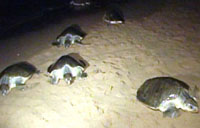|
Travel Sites Visit
Goa, Karnataka,
Kerala, Tamil
Nadu, Andhra Pradesh |
Govt inaction in Olive Ridley deaths
 |
Bhubaneshwar: Gory reminders of everyday deaths of endangered Olive Ridley turtles on the pristine beaches of Orissa formed the backdrop to a Greenpeace demonstration on Monday in Bhubaneshwar. Greenpeace activists blamed the Indian government for inaction, saying it had not adhered to the apex court orders asking wildlife authorities to demarcate fishing and non-fishing zones. "Our consciences are clear. We have not broken any law. We have not done anything that is unjust, illegal or bad. The reality is that this is something that needs to be done. The Supreme Court, the highest court in the land, has asked for this to be done. Thousands of turtles are dying every year and the government is doing nothing. When someone comes in to try and help in a bit to resolve the situation, they say they are harassed in this manner," said Ashish Fernandes, Ocean campaigner of Greenpeace.
However, the Chief Wildlife Warden of Orissa, Suresh Mohanty, counters the allegations saying that the turtles' deaths had, in fact, gone down over years. "Turtle casualties are not increasing in Devi river mouth or any area at the coast of Orissa. The total number of casualties have gone down compared to previous years even the years before that. So over the years since 2003, a considerable reduction has been achieved in the number of turtle casualties. Earlier, they were in the range of 12,000 to 13,000 in a year, this year they have come down to 3000," said Suresh Mohanty.
The Olive Ridley turtle, which can grow up to 75 cm (2.5 feet) in length, is found in tropical regions of the Pacific, Atlantic and Indian Oceans. Every year as winter rolls around, the endangered species move in large synchronised concentrations to three major nesting sites along the Orissa coast by the Bay of Bengal, considered one of the world's major nesting grounds.
 |
After the young ones are hatched, the turtles return to the sea. With each turtle laying an estimated 120 eggs, large stretches of the state's coastline get packed with them. Wildlife officials say over 250,000 turtles make their annual trek to the nesting sites. In 2004 over one million turtles came to the Orissa shores to dig pits and lay eggs, the largest concentration being at Gohirmatha beach. Such large concentrations only occur at a few sites in the world. In the year 2000, only 700,000 turtles arrived but in 1997 and 1998, the turtles skipped the annual ritual and there was no mass nesting at all.
Experts
say turtles are particularly vulnerable because of high mortality rates.
According to studies, only one out of every 1,000 hatchlings normally
reaches adulthood. The reptiles are mangled by fishing trawler propellers,
or suffocated in fishermen's gill nets. They are also killed by pollution
and by poachers, who hunt them for their meat. The Orissa State Government
has declared the whole nesting area a marine sanctuary and has banned
mechanised trawlers in the state. Besides, it has also urged local fishermen
to include Turtle Excluding Devices in their fishing equipment.
April 3, 2006
Tourist
offices
in India
|
Window
on India |
|
News
Links |